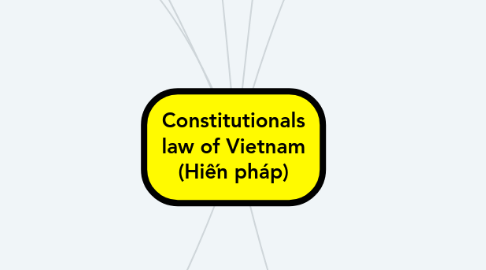
1. To govern vital malters of Vietnam
2. Constitution = supreme law
2.1. Contains a set of fundamental rules laying basic principles
2.1.1. Organisation of state power
2.1.2. Establishment and operation of the state organs
2.1.3. Political, economic, social and cultural regimes
2.1.4. Fundamental rights & obligations of citizens
2.2. Has highest effect in the Vietnamese legal system
2.3. Bind on everyone in the state including ordinary lawmaking institutions
2.4. The laws must comply with the principles regulated in the consitution
3. How is state power organised in the constitution?
3.1. The people who have the highest state power in Vietnam are the citizens
3.2. Principles of the organization
3.2.1. State power belongs to the people
3.2.2. State power is unified
3.2.3. State power is organised democratically
3.2.4. State organs coordinate with and control each other in execution of state power
3.2.5. Organisation and execution of state power must comply with laws
3.3. People exercise state power
3.3.1. Directly
3.3.1.1. Standing for election to the National assembly or people’s council
3.3.2. Indirectly
3.3.2.1. through representative organs
3.4. Division of state power
3.4.1. Legislative (enact laws)
3.4.1.1. National assembly (Quốc hội)
3.4.2. Executive (enforce laws)
3.4.2.1. Government
3.4.3. Judical (interpret, apply laws)
3.4.3.1. Courts (Tòa án)
4. How is the economy, technology, environment, science, education and culture regulated in the constitution?
4.1. Economy
4.1.1. Socialist-oriented market economy
4.1.1.1. The state play the dominant role
4.1.1.2. Includes various forms of ownership and economic sectors
4.2. Education
4.2.1. Top national policy to develop human resources
4.2.2. School system
4.2.2.1. Care for pre-school education;
4.2.2.2. Ensure free compulsory primary education
4.2.2.3. Gradually universalize secondary education
4.2.2.4. Develop higher education and vocational education
4.2.3. In all areas in Vietnam
4.3. Culture
4.3.1. Deeply imbued with the national identity and has absorbed the cultural quintessence of humanity
4.4. Tech and science
4.4.1. Top national policy
4.4.1.1. Key role in national socio-economic development
4.4.2. Encourage to invest in, research, develop, transfer the achievements
4.5. Environment
4.5.1. Encourage protection
4.5.2. Any act polluting environment must be rectified and charged for compensation,
5. How many constitution have been enacted in Vietnam?
5.1. Why VN changes the constitution more often?
5.1.1. Viet Nam uses the Civil Law (issue laws through legal documents)
5.1.1.1. Misunderstanding between law makers and enforcers
5.1.1.2. Many laws are not suitable anymore
5.2. 5: 1946, 1959, 1980, 1992, 2013
6. What are the fundamental rights and obligations of Vietnamese citizens regulated in the constitution?
6.1. Rights and obligations are inseparable
6.2. Rights
6.2.1. Democracy and individuals freedoms
6.2.1.1. Freedom of speech and press
6.2.1.2. Freedom of movement and residence
6.2.1.3. Right to invidability of body/home
6.2.1.4. The right of access to information, assembly, association and demonstrattion
6.2.2. Political
6.2.2.1. Participate in management of the state, discussion with the state organs
6.2.2.2. Vote/stand for election to national assembly or people's councils
6.2.2.3. Make complaints or denunciations about illegal acts of individuals, organization, agencies
6.2.3. Economic, cultural and social
6.2.3.1. Rights to work
6.2.3.2. Rights to educatation
6.2.3.3. Rights to marry and divorce
6.2.3.4. Rights to gender equality
6.3. Obligations
6.3.1. Be loyal and defend the fatherland
6.3.2. Obey the constitution and law, pay taxes
7. How is Vietnamese state structured according to the constitution?
7.1. National Assembly (Legislative)
7.1.1. To draw up and amend the Constitution; make and amend Laws
7.1.2. Duration of each term: 5 years, holds 2 sessions/year
7.1.3. Deputies
7.1.3.1. Represent the WILL & ASPIRATIONS of the People
7.2. National President
7.2.1. Head of State
7.2.2. Be elected by the National Assembly
7.2.3. Represents the Socialist Republic of Vietnam in both domestic and foreign affairs
7.2.4. Duration: follows the National Assembly’s duration
7.3. Government (Excutive)
7.3.1. Highest state administrative body
7.3.2. Be elected by the National Assembly
7.3.3. Duration: follows the National Assembly’s duration (usually 5 years)
7.3.4. The executive of National Assembly
7.3.5. Power and Functions
7.3.5.1. Manage the economy, culture, social affairs, education, health, science, ...
7.3.5.2. Enact legal documents
7.4. People's Court; People's Procuracy (Judicial)
7.4.1. Responsible for the protection of justice, rights & interests of organizations and individuals
7.4.2. Decisions of People’s Courts must be RESPECTED & FULLY COMPLIED WITH Nation Assembly
7.5. Local Government
7.5.1. Administrative units of state
7.5.1.1. The country is DIVIDED into Provinces & Cities under DIRECT CENTRAL RULE.
7.5.2. Organize and ensure the implementation of Constitution & the laws at LOCAL LEVEL
7.5.3. Duration: 5 years
7.5.4. Elected by the local people
